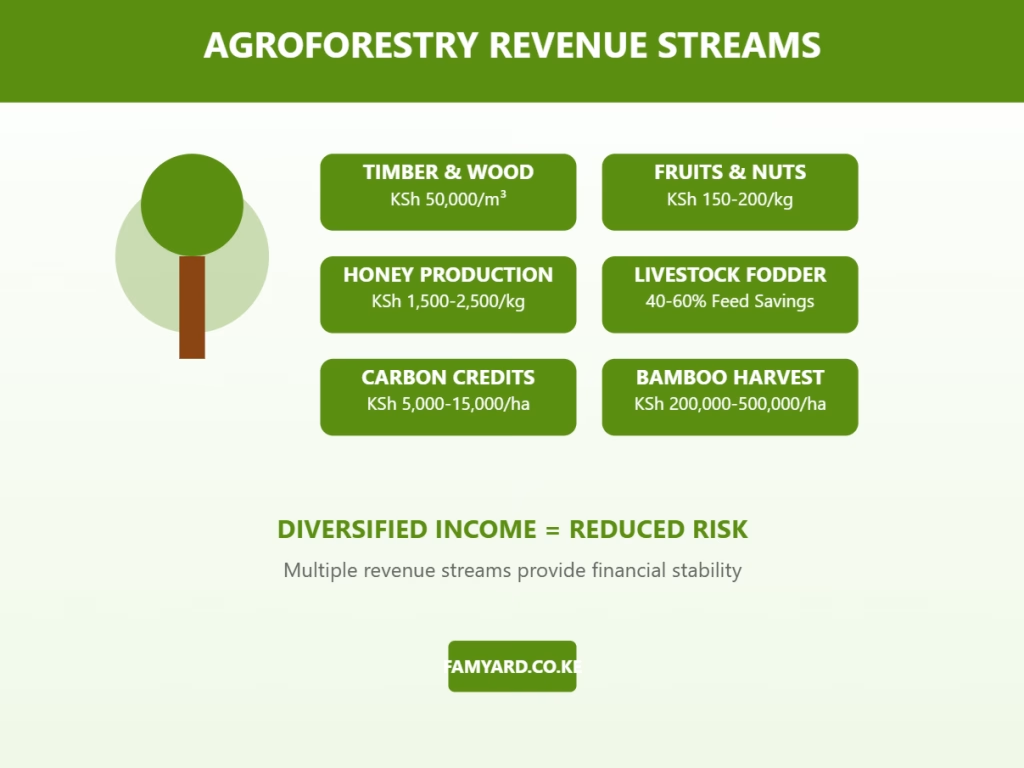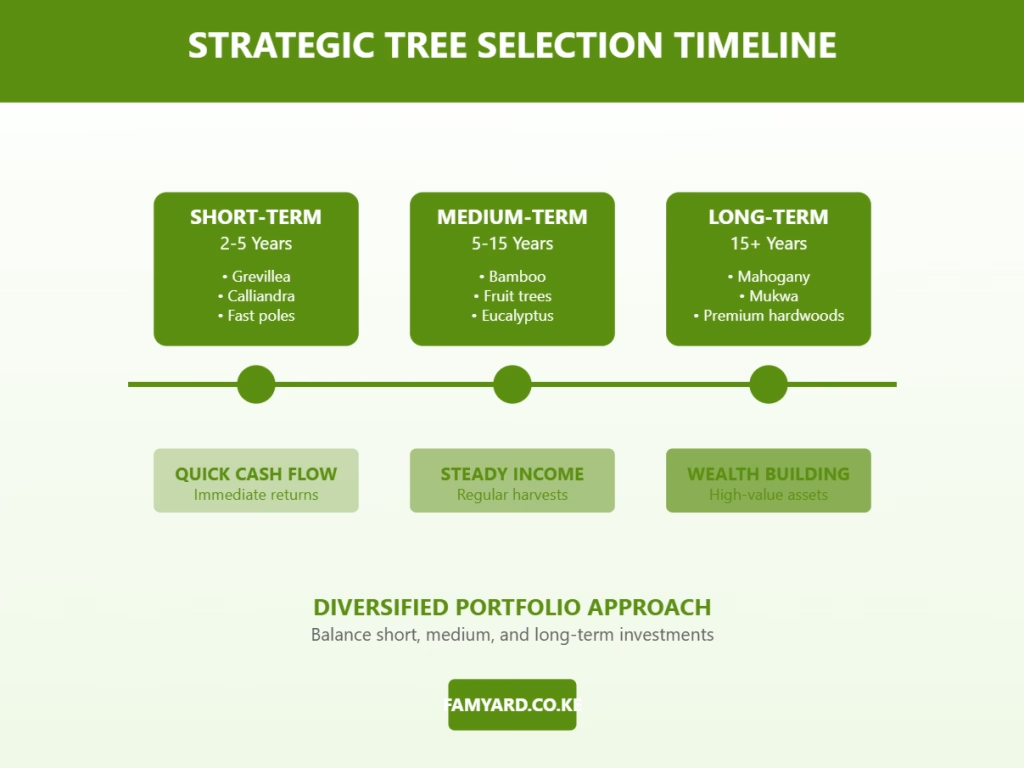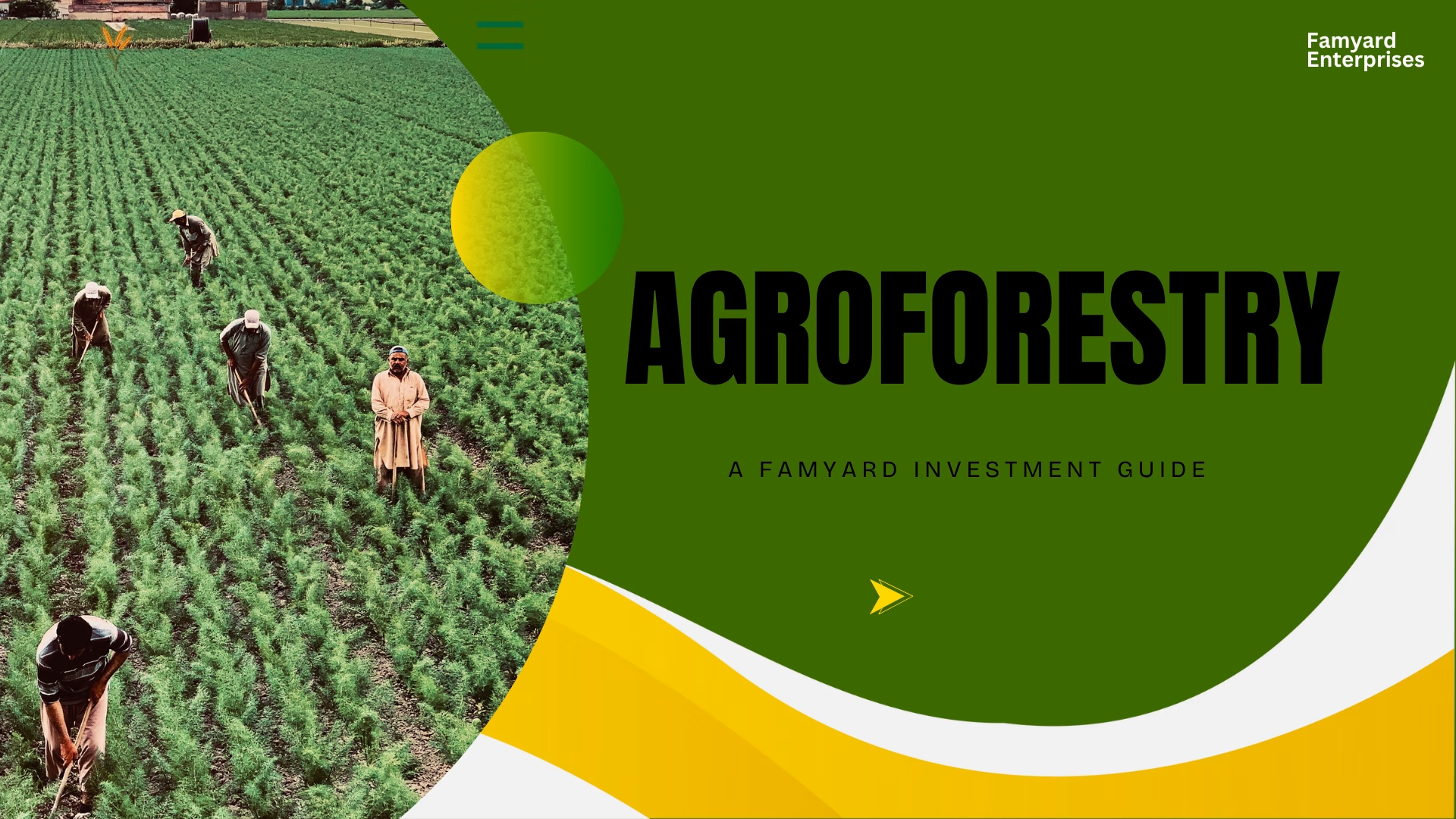Agroforestry isn’t just an environmental buzzword, it’s a proven path to increased farm profitability that smart Kenyan farmers are already capitalizing on. By integrating trees with crops and livestock, you’re not just diversifying your land use; you’re creating multiple income streams that can weather market volatility and climate challenges.
Understanding the Revenue Streams
The beauty of agroforestry lies in its multiple profit centers. Unlike monoculture farming where you’re betting everything on one crop, agroforestry creates a financial safety net through diversification.

Timber and Wood Products
This section represents your long-term investment strategy. Fast-growing species like eucalyptus can be harvested in 7-10 years, while hardwoods like mahogany build generational wealth over 20-30 years. The key is selecting species that match your timeline and market demand. In Kenya’s construction boom, indigenous timber commands premium prices, with some species fetching over KSh 50,000 per cubic meter.
Fruit and Nut Production
It offers medium-term returns with annual income potential. Avocados, mangoes, and macadamia nuts have established export markets, with macadamia nuts alone earning farmers KSh 150-200 per kilogram. The secret is choosing varieties that align with your climate zone and have proven market demand.
Non-Timber Forest Products
These products create immediate cash flow opportunities. Honey production through beekeeping can generate KSh 1,500-2,500 per kilogram for quality honey. Mushroom cultivation using tree substrates, medicinal plant harvesting, and even ecotourism activities add layers to your income portfolio.
Strategic Tree Selection for Maximum Returns
Your tree selection strategy determines your profitability timeline. Think of it as building an investment portfolio with short, medium, and long-term assets.

For quick returns within 2-5 years, focus on fast-growing species. Grevillea robusta serves dual purpose, providing construction poles while fixing nitrogen for your crops. Calliandra produces high-protein fodder that can reduce livestock feed costs by 40-60%, directly impacting your bottom line.
Medium-term investments spanning 5-15 years should include fruit trees and specialty timber. Bamboo has emerged as a goldmine, with mature stands generating KSh 200,000-500,000 per hectare annually through culm harvesting for construction and crafts.
Your long-term wealth builders are hardwood species and premium fruit varieties. Indigenous trees like mukwa and mvule appreciate significantly over time, while established avocado orchards can generate KSh 300,000-800,000 per hectare annually at maturity.
Market-Driven Crop Integration
Success in agroforestry requires understanding how trees enhance rather than compete with your primary crops. This symbiotic relationship is where the magic happens financially.
Coffee farmers practicing agroforestry report 15-30% higher yields due to improved microclimate conditions. The shade trees don’t just protect coffee plants they create additional income through timber, fruit, or carbon credits. Similarly, tea farmers integrating nitrogen-fixing trees reduce fertilizer costs while improving soil health.
For food crop farmers, the alley cropping system maximizes land efficiency. Rows of trees create microclimates that extend growing seasons and improve water retention. Farmers report maize yields increasing by 20-40% in well-designed agroforestry systems, while simultaneously harvesting tree products.
The livestock component adds another profit dimension. Silvopasture systems where trees, grass, and animals coexist can increase carrying capacity by 25-50% while reducing feed costs through fodder trees and improved grass production.
Financial Planning and Investment Strategies
Agroforestry requires upfront investment but delivers compounding returns. Your initial costs include seedlings, labor for planting, and potential irrigation infrastructure. Budget KSh 20,000-50,000 per hectare for establishment, depending on species diversity and infrastructure needs.
The cash flow challenge in years 1-3 is real, but strategic planning mitigates this. Inter-cropping with annual crops maintains immediate income while trees establish. Many farmers successfully fund their agroforestry transition through continued traditional farming on portions of their land.
Government incentives sweeten the deal. The Kenya Forest Service provides subsidized seedlings, while various programs offer grants for agroforestry adoption. Carbon credit programs are emerging, with potential earnings of KSh 5,000-15,000 per hectare annually for qualifying projects.
Bank financing is increasingly available for agroforestry projects. Several financial institutions now offer specialized loans recognizing trees as bankable assets. The key is presenting a solid business plan showing projected cash flows and market analysis.
Marketing and Value Addition Opportunities
Raw product sales represent just the beginning of agroforestry profitability. Value addition multiplies your returns significantly.

- Timber processing adds 200-400% value over selling raw logs. A simple sawmill operation or partnership with processors transforms your harvest economics. Similarly, fruit processing, making juices, dried fruits, or value-added products captures more of the value chain.
- Direct marketing strategies bypass middlemen and improve margins. Farmers’ markets, online platforms, and direct-to-consumer sales often double farm-gate prices. Building relationships with hotels, restaurants, and institutional buyers creates stable, premium-priced outlets.
- Export opportunities exist for quality products. Kenyan avocados, macadamia nuts, and specialty timber have international demand. While export requires meeting quality standards and certifications, the price premiums justify the investment.
- Agritourism represents an emerging opportunity. Well-designed agroforestry systems attract visitors interested in sustainable agriculture, creating additional revenue through farm tours, workshops, and accommodation.
Technology and Modern Approaches
Modern agroforestry leverages technology for optimization and profitability. GPS mapping and drone surveys help design optimal tree placement for maximum yield and efficiency. Moreover, soil testing guides species selection and fertilizer applications, reducing input costs while maximizing growth rates.
Mobile apps connect farmers to markets, weather information, and technical support. Digital platforms facilitate direct sales and eliminate intermediaries, improving profit margins significantly.
Precision agriculture techniques such as drip irrigation, fertigation, and monitoring systems ensure optimal resource use. While requiring initial investment, these technologies often pay for themselves through improved yields and reduced operational costs.
Data collection and analysis drive decision-making. Tracking growth rates, yield data, and financial performance identifies the most profitable combinations and informs future expansion decisions.
Risk Management and Sustainability
Diversification inherent in agroforestry reduces various risks that threaten single-crop operations. Market price volatility affects different products differently, spreading risk across your portfolio. Climate resilience improves as trees moderate temperature extremes and improve water retention.
Insurance options for agroforestry are expanding. Crop insurance increasingly covers tree crops, while some insurers offer specialized forestry coverage. The key is documenting your investments and maintaining proper records.
Sustainable practices ensure long-term profitability. Soil health improvement through agroforestry creates compounding benefits over time. Water conservation techniques reduce operational costs while ensuring production continuity during dry periods.
Pest and disease management in diverse systems relies less on expensive inputs. Natural predators thrive in agroforestry environments, reducing pesticide costs while maintaining productivity.
